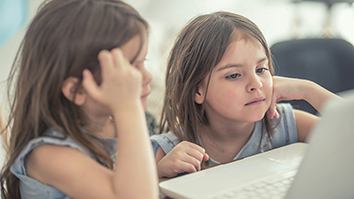
Most YouTube videos intended to teach early literacy and math don’t use characters or narratives, according to recent SRI research.
There is an enormous volume of video content for kids on YouTube, and increasingly, that’s where young children are spending their time. Research shows that, as of 2020, kids under the age of six spend more time watching videos on YouTube than watching TV.
“This is a huge shift,” said Claire Christensen, a senior education researcher at SRI. “What they’re watching isn’t made by studios – for the most part, now it’s made by everyday people. And we just don’t know how that can affect growth, well-being, or learning.”
Christensen and her colleagues at SRI have been investigating the content of YouTube videos intended to teach early literacy and math to kids in pre-K and kindergarten. Their findings, published recently in a white paper, show that YouTube videos often miss some of the key characteristics that help children learn while they watch.
Less than half of the 1,200 videos that the researchers analyzed included characters. Instead, many of them used educational songs that lack a host or character for kids to connect with. “That is, in my professional opinion, a huge departure from kids’ TV shows. I can’t name a kids’ TV show that doesn’t have a recognizable, lovable character,” Christensen said. “Research shows that having a person on screen that feels like a friend is what draws kids in and makes them want to learn.”
The researchers also note that the videos rarely incorporated learning into a narrative story, and only about half of the videos directly addressed the audience to encourage interaction, the way that TV shows like Blue’s Clues or Dora the Explorer do. That doesn’t mean that these videos are bad for children, but they’re missing some of the research-backed characteristics that improve comprehension.
Children’s media doesn’t always need to be educational to be helpful, Christensen said. Many parents use videos as a tool to redirect a kid’s attention and give themselves a moment to get something important done or just calm down after a hard day. “During the pandemic, it became apparent how useful screen time can be when you don’t have outside resources, whether it’s to give parents ten minutes to start dinner or feed a baby or anything else,” Christensen said. “There are ways to use screen time to benefit your family even if it’s not educational.”
“Research shows that having a person on screen that feels like a friend is what draws kids in and makes them want to learn.” — Claire Christensen
For concerned parents, Christensen recommends balancing YouTube content with educational TV shows, at least until there is more research on the effects of this new style of children’s media. Educational TV shows provide opportunities for children to bond with particular characters and experience narrative-based learning, as well as potentially encouraging a longer attention span. She also recommends that parents engage with their kids about what they’ve learned from the content that they are watching on YouTube.
“Because these shows aren’t encouraging kids to talk back as much or using characters that kids are connecting with, it’s important for parents to be that connection point instead,” Christensen said. “If your kid has been watching a lot of stuff on YouTube, try talking to them about it and connect it to their life. That might help the content feel more relatable.”
Christensen and her colleagues are already working on the next steps. They are using data from this study to begin training a machine-learning model that will comb through large amounts of videos and analyze what kids are watching. They hope to get a better picture of how children’s media use has changed and what that means for families moving forward.
“The goal of this whole body of research is to understand how parents are using children’s media, both as an educational tool and as a tool to meet their family’s needs more broadly,” said Christensen. “We want to figure out how to help families use screen time in ways that work for them.”


